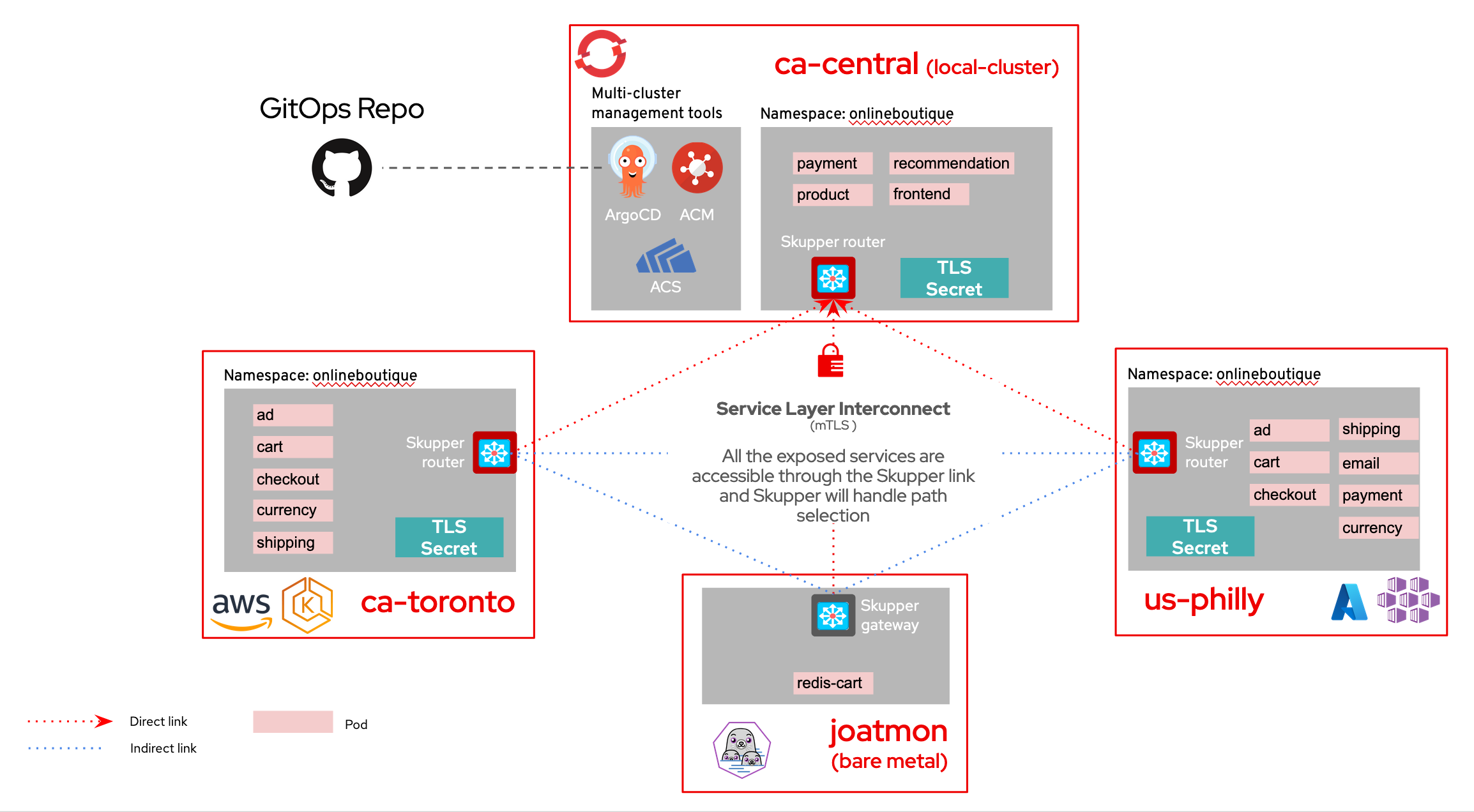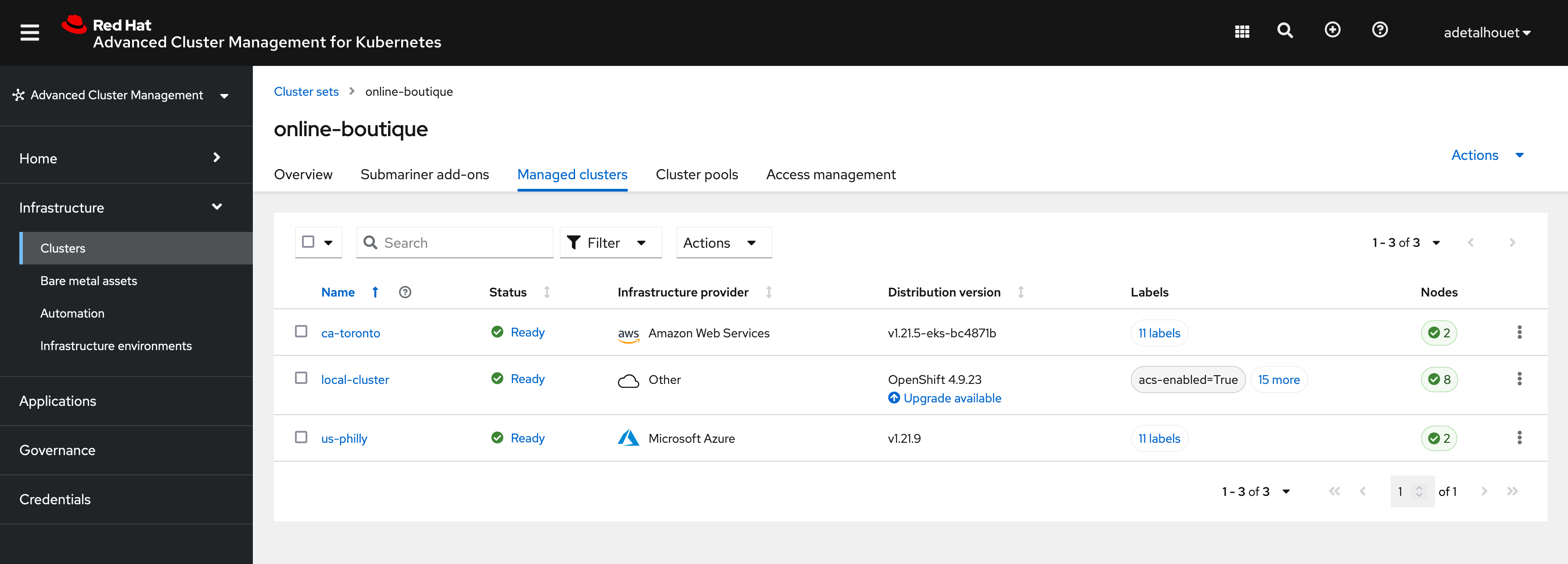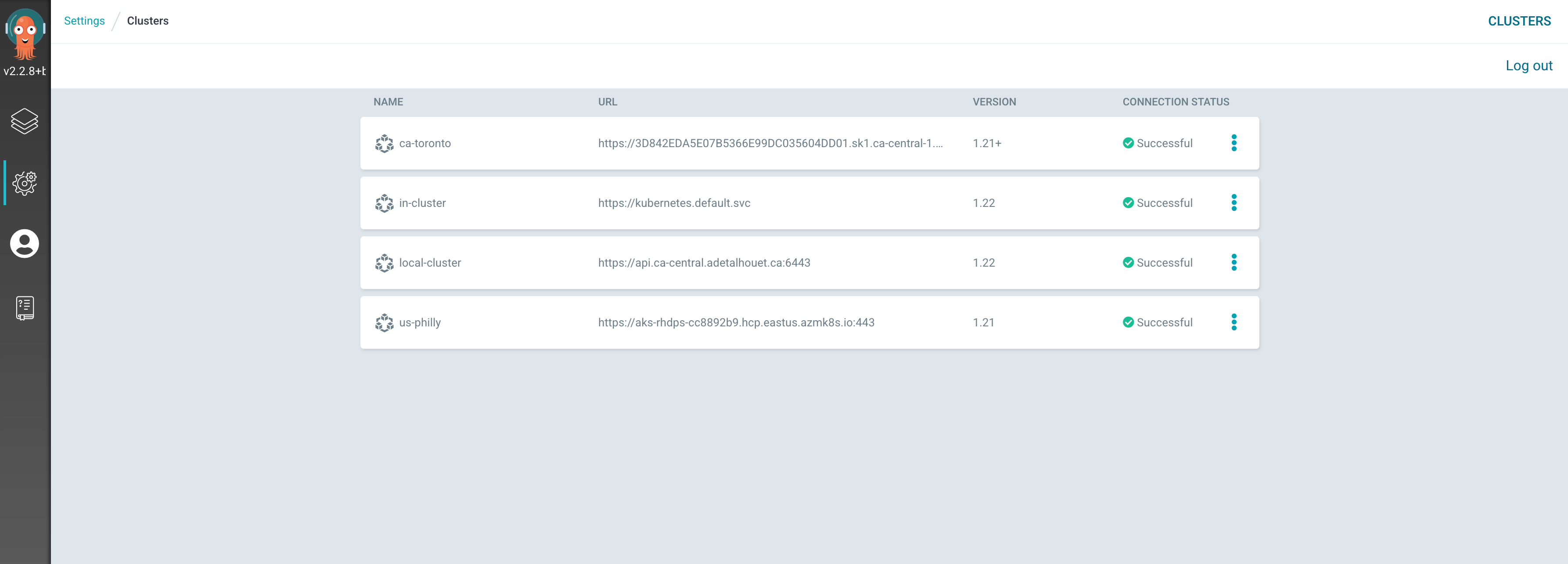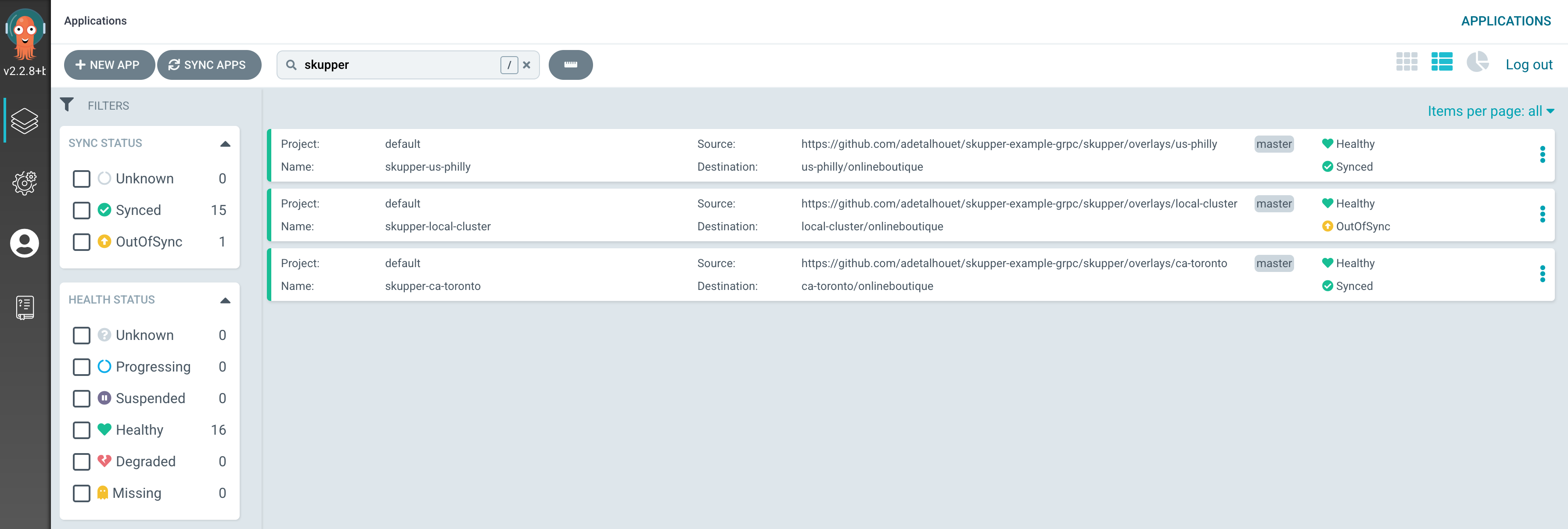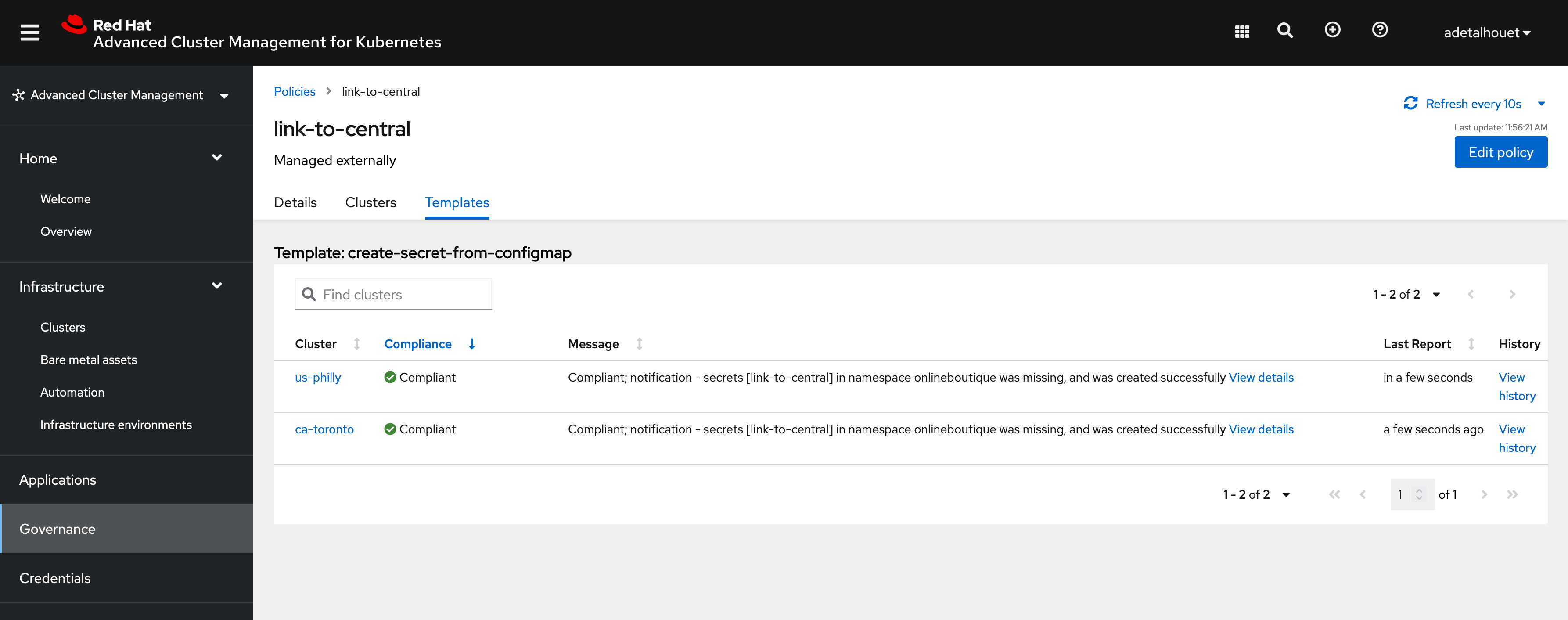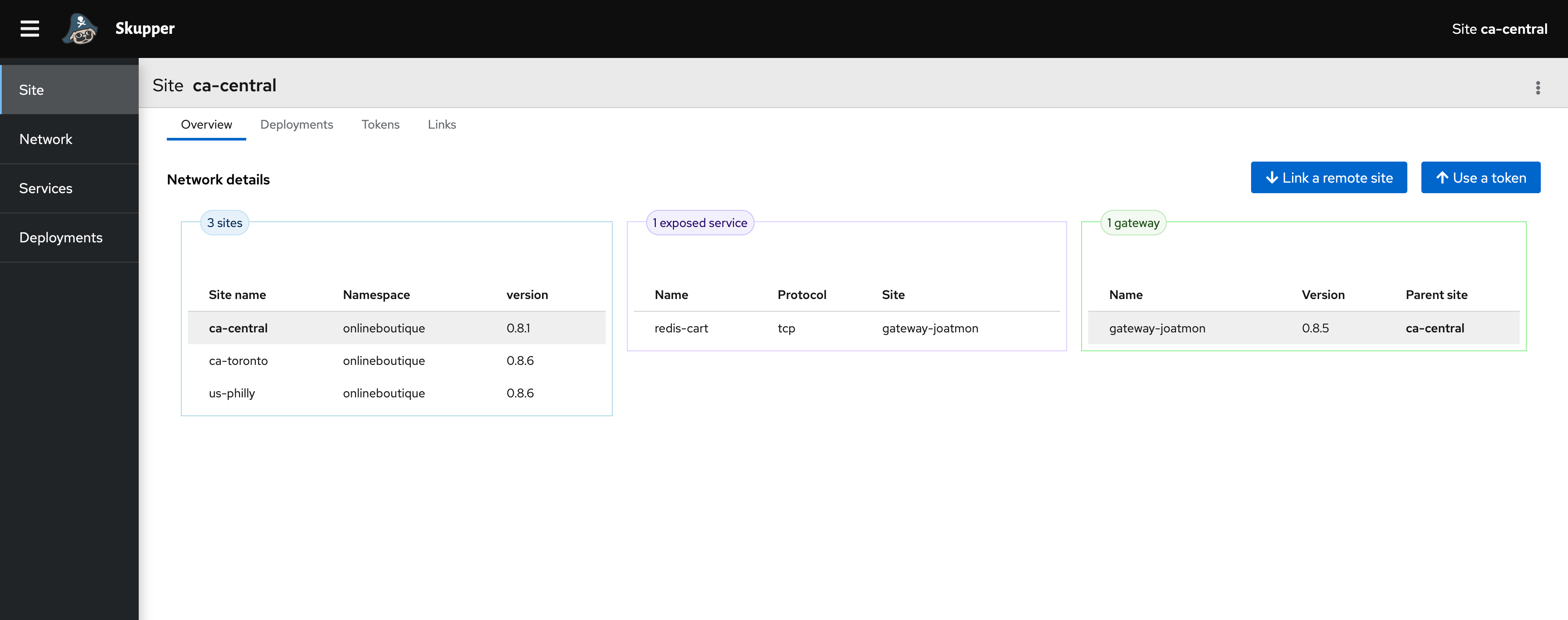This tutorial demonstrates how to deploy the Online Boutique microservices demo application across bare metal and multiple Kubernetes clusters that are located in different public and private cloud providers. This project contains a 10-tier microservices application developed by Google to demonstrate the use of technologies like Kubernetes.
In this tutorial, you will create a Virtual Application Network, using Skupper, that enables communications across a bare metal server, the public and private clusters. You will then deploy a subset of the application's grpc based microservices to each environment, using an ArgoCD ApplicationSet.
You will then be able to access the Online Boutique web interface to browse items, add them to the cart and purchase them.
- Overview
- Multi-cluster setup
- Deploy the Virtual Application Network
- Deploy the application
- Rotate TLS certificates
- TLDR
- Red Hat OpenShift 4.9
- Red Hat Advanced Cluster Management 2.4
- OpenShift GitOps on the cluster where RHACM is installed
- At two clusters that are imported into RHACM (could be 2 or more)
- One bare metal server (could be a VM)
I have the following clusters already imported in RHACM.
$ oc get managedcluster
NAME HUB ACCEPTED MANAGED CLUSTER URLS JOINED AVAILABLE AGE
ca-toronto true https://3D842EDA5E07B5366E99DC035604DD01.sk1.ca-central-1.eks.amazonaws.com True True 47h
local-cluster true https://api.ca-central.adetalhouet.ca:6443 True True 62d
us-philly true https://aks-rhdps-cc8892b9.hcp.eastus.azmk8s.io:443 True True 2d1h
local-cluster is reference below as ca-central. All the operations below will be executed against that cluster.
When RHACM manages a cluster, it creates a namespace that have its name, and uses this namespace to host information it controls, such as policies generated for that cluster.
In order to manage the various K8S clusters, we create a ManagedClusterSet called online-boutique in Red Hat Advanced Cluster Management. To add clusters in this clusterSet, we need to add the following label cluster.open-cluster-management.io/clusterset=online-boutique to the ManagedClusters to import.
This clusterSet is then bound to a specific namespace, using a ManagedClusterSetBinding. This allows ACM to take action in these clusters through that namespace. In our case, we will bound the clusterSet to openshift-gitops namespace, as this is where we will deploy ArgoCD ApplicationSet.
Apply the following
oc apply -f managed-cluster-set.yaml
oc label managedcluster ca-regina cluster.open-cluster-management.io/clusterset=online-boutique
oc label managedcluster local-cluster cluster.open-cluster-management.io/clusterset=online-boutique
This is the result in RHACM
Find more information about ManagedClusterSet
Now that we created the grouping of clusters to work with, let's import them in ArgoCD. Do to so, we need to create a GitOpsCluster that will define where is the ArgoCD to integrate with, along with the Placement rule to use. In our case, we will use the label local-argo: True to denote clusters that should be imported.
In case you are importing non-OCP clusters, please follow these instructions first.
Apply the following
oc apply -f gitopscluster.yaml
oc label managedcluster ca-regina local-argo=True
oc label managedcluster local-cluster local-argo=True
This is the result in ArgoCD
Find more information about the integration of ACM with ArgoCD
Skupper is the technology being used to interconnect the K8S clusters together, along with our database that resides in a bare metal server.
Find more information about Skupper here.
In order to deploy Skupper across all the 2 clusters, we will use an ArgoCD ApplicationSet. It will use the clusterDecisionResource generator and will use a Placement rule using the label online-boutique: True to match clusters for which to generate an Application.
To customize the manifest deployed in each site, we are using Kustomize with one overlay folder per cluster, matching the cluster name.
Both our clusters are supporting Operator Lifecycle Manager, but if yours isn't, we have two methods of deploying Skupper site controller: one using the Skupper operator, one using the manifests.
The way to deploy Skupper router is common to all site, and will be customized with the site name and site specific authentication method.
Apply the following
oc create -f online-boutique-placement.yaml
oc label managedcluster ca-toronto online-boutique=True
oc label managedcluster us-philly online-boutique=True
oc label managedcluster local-cluster online-boutique=True
oc apply -f skupper/appset-skupper.yaml
This is the result in ArgoCD. It is expected the skupper-local-cluster ArgoCD Application shows out-of-sync, we will explain later why this is useful.
In each site, in the namespace onlineboutique you should see the Skupper pod. At this point, there is no connectivity between the sites.
Skupper rely on an mTLS to establish a Virtual Application Network. As such, it requires a Secret containing the certificate authority, the certificate and the key to be present in all sites.
To have Skupper populating the TLS data into a secret, we can simply create an empty secret with this label skupper.io/type: connection-token-request. Skupper site controller will populate all the required information in this secret automatically. In our example, the secret will be generated in the ca-central.
Given we are deploying the secret using GitOps, as soon as Skupper adds data into it, ArgoCD will report the secret out-of-sync. This is expected, and we purposely disabled self-heal in this ArgoCD Application because we do tolerate this out-of-sync. We will see later why it is very useful.
Once the TLS data exists, it needs to be provided to the other sites in order to setup the mTLS session. To do so, we will use an RHACM Policy along with templating functions to copy the secret data over the remote sites. The policy will match clusters based on the PlacementRule defined; in our case, it is matching cluster with label link-to-central: True.
As defined in the policy, using the templating functions, the secret looks like this:
kind: Secret
apiVersion: v1
metadata:
name: link-to-central
namespace: onlineboutique
labels:
skupper.io/type: connection-token
annotations:
edge-host: '{{hub ( index ( lookup "v1" "Secret" "onlineboutique" "link-to-central").metadata.annotations "edge-host" ) hub}}'
edge-port: '443'
inter-router-host: '{{hub ( index ( lookup "v1" "Secret" "onlineboutique" "link-to-central").metadata.annotations "inter-router-host" ) hub}}'
inter-router-port: '443'
data:
ca.crt: '{{hub ( index ( lookup "v1" "Secret" "onlineboutique" "link-to-central").data "ca.crt" ) hub}}'
tls.key: '{{hub ( index ( lookup "v1" "Secret" "onlineboutique" "link-to-central").data "tls.key" ) hub}}'
tls.crt: '{{hub ( index ( lookup "v1" "Secret" "onlineboutique" "link-to-central").data "tls.crt" ) hub}}'
type: Opaque
RHACM will render this policy and will place it in each cluster's namespace, based on the matched clusters. These generated policies are also the source of our skupper-local-cluster ArgoCD Application out-of-sync status. Again, this is expected, and we will see later why it is very useful.
Given we already deployed the Skupper ApplicationSet previously, let just add the label to have the secret containing the TLS information propageted to our two remote sites.
oc label managedcluster ca-toronto link-to-central=True
oc label managedcluster us-philly link-to-central=True
This is the result you should observe in RHACM
Find more information about ACM Policy template
The last piece of our architecture is connecting the bare metal server to our Virtual Application Network. As part of the overall application, our goal is to host the redis database on bare metal, and reference it using the redis-cart name.
In order to provide the redis service in our link fabric, we will create a Skupper gateway that will connect to our ca-central site, and we will expose the service using it's IP/PORT.
Run the following in your sever to deploy Redis and expose the redis service.
podman run -d \
--name redis_server \
-v $PWD/redis-data:/var/redis/data \
-p 6379:6379 \
redis
skupper gateway expose redis-cart 10.0.0.249 6379 --protocol tcp -c ca-central -n onlineboutique --type podman --name gateway
To verify the service is properly exposed, you can use the following command
$ skupper gateway status -n onlineboutique -c ca-central
Gateway Definitions:
╰─ gateway type: podman version: 1.17.1 url: amqp://127.0.0.1:5672
╰─ Bindings:
╰─ redis-cart:6379 tcp redis-cart:6379 10.0.0.249 6379
Now, let's look into the Skupper UI, from the ca-central to validate the link is created between the three sites, that our gateway has been properly registered, and that the redis-cart service is available.
Retrieve the Route to access Skupper from our ca-central cluster
$ oc get route -n onlineboutique skupper
NAME HOST/PORT PATH SERVICES PORT TERMINATION WILDCARD
skupper skupper-onlineboutique.apps.ca-central.adetalhouet.ca skupper metrics reencrypt/Redirect None
The application is provided through a Helm chart, where all the various microservice are defined. In order to specify which microservice will be deployed where, we have created site specific Values.yaml file, prefixed with the name of the site.
Similarly as the Skupper site controller deployment, we are using an ApplicationSet that will use the same placement rule defined prior e.g. using label online-boutique: True.
Finally, we have added a load generator in the ca-central site in order to simulate traffic in our website.
Apply the following to deploy the ApplicationSet
oc apply -f online-boutique/appset-online-boutique.yaml
The ArgoCD Application should be deployed and shown in ArgoCD
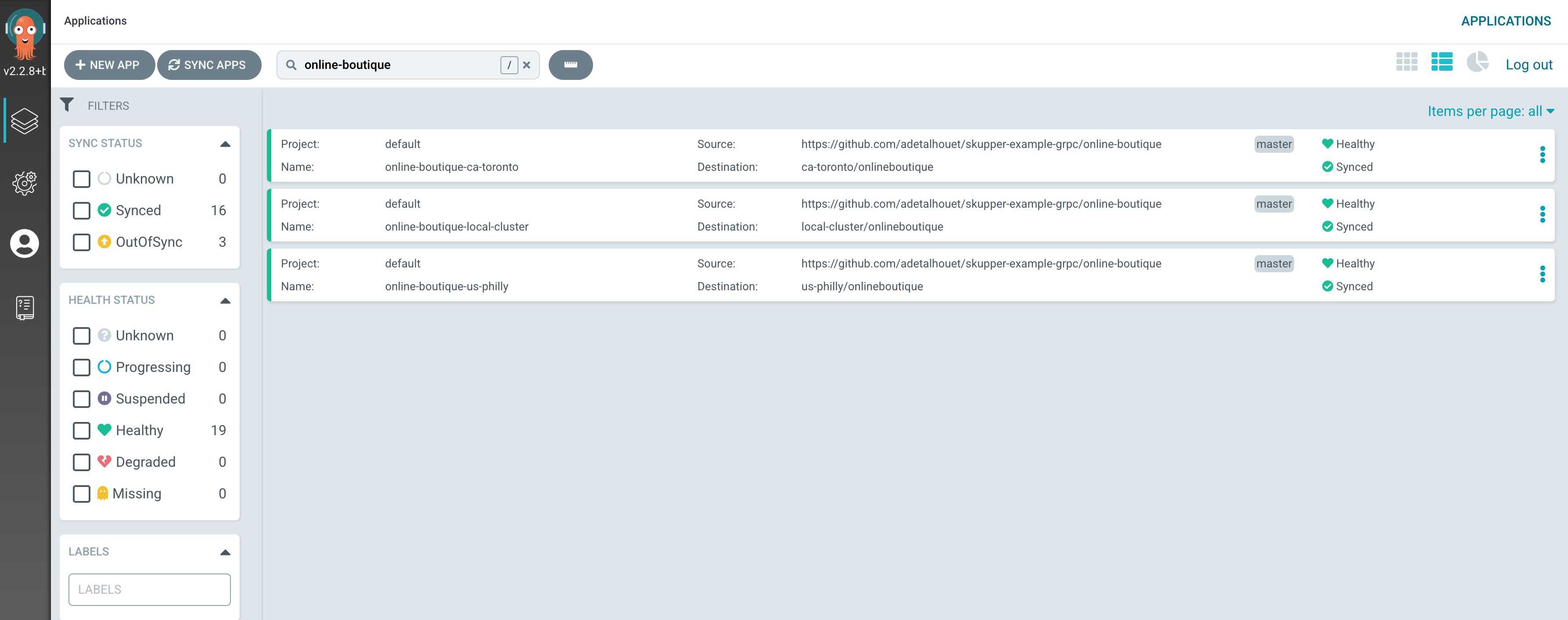
We can see in Skupper all the services exposed
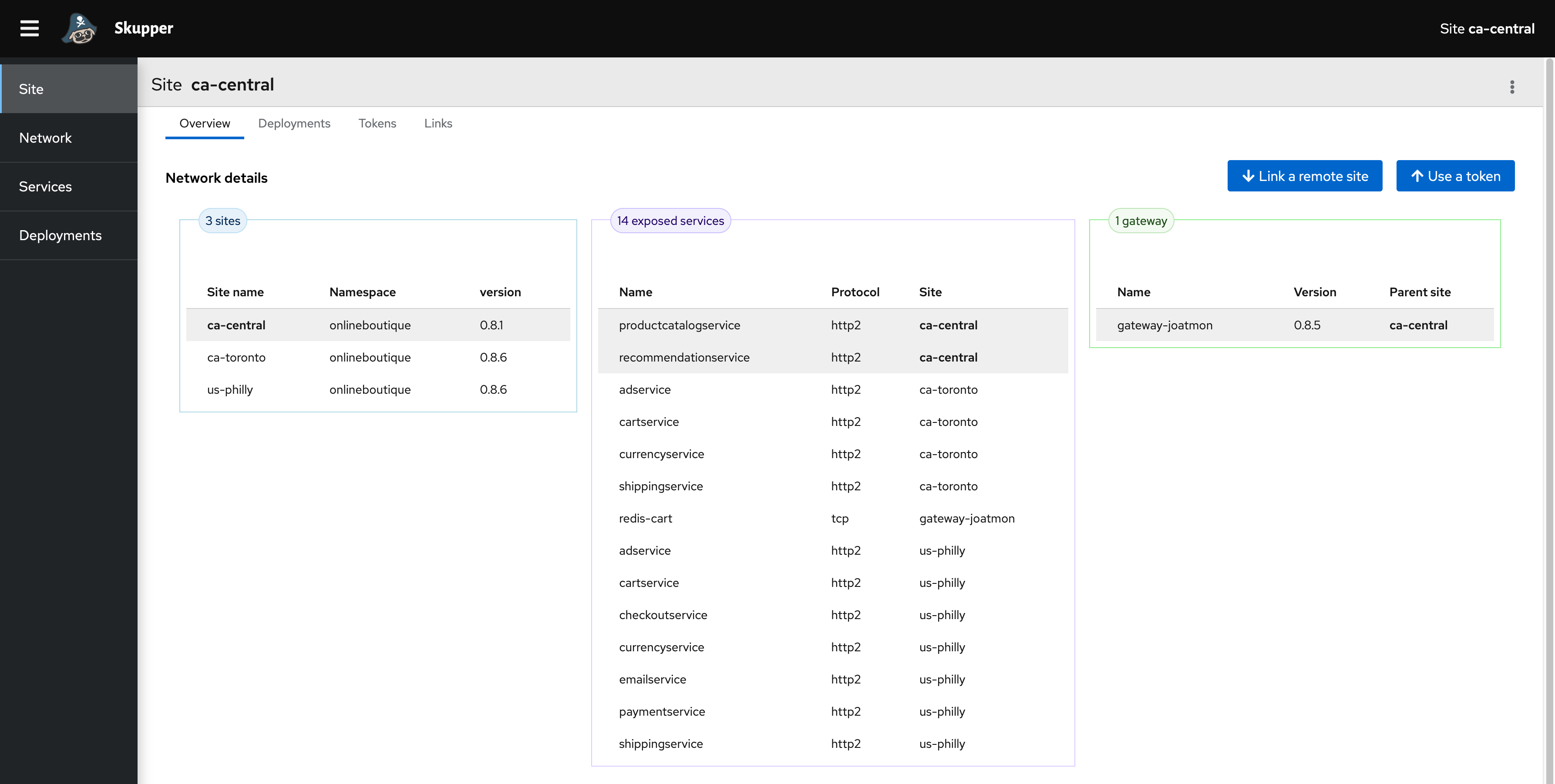
If all was done correctly, you should see the services interacting with each others

Retrieve the route from the ca-central cluster and access the online boutique
$ oc get route -n onlineboutique frontend
NAME HOST/PORT PATH SERVICES PORT TERMINATION WILDCARD
frontend frontend-onlineboutique.apps.ca-central.adetalhouet.ca frontend http None
Skupper is able to route traffic by assessing the best path to use, considering application load and link latency. In our deployment, couple of microservices are deployed in both us-philly and ca-toronto sites, to demonstrate this built-in Skupper capability. It can be observed in the service interaction, but also when looking at a service itself.
This also enables failover scenarios, with active-active setup. If one site goes down, the application will continue to work, and Skupper will be the one routing the traffic to the proper endpoint.
If the TLS data has been compromized or needs to be rotated, the only operation to do is a sync in ArgoCD skupper-local-cluster Application.
As explain above, the secret and the generated policies are either in out-of-sync state of require prunning state.
By doing a sync with pruning and replace options enabled,
ArgoCD will:
- delete the secret
- delete the generated policies
- re-create the secret
Skupper will:
- add new TLS certificate authority, certificate and key to the secret
ACM will:
- generate new policies for the cluster matching its placement rule
While doing so, you might observe a brief traffic interuption, and Skupper will have to recreate the links from the remote sites to the central site.
Below are the all-in-one commands to run from the bare metal server which have access to the ca-central cluster.
# Create cluster set
oc apply -f managed-cluster-set.yaml
oc label managedcluster ca-toronto cluster.open-cluster-management.io/clusterset=online-boutique
oc label managedcluster us-philly cluster.open-cluster-management.io/clusterset=online-boutique
oc label managedcluster local-cluster cluster.open-cluster-management.io/clusterset=online-boutique
# Import clusters in ArgoCD
oc apply -f gitopscluster.yaml
oc label managedcluster ca-toronto local-argo=True
oc label managedcluster us-philly local-argo=True
oc label managedcluster local-cluster local-argo=True
# Create Virtual Application Network
oc create -f online-boutique-placement.yaml
oc label managedcluster ca-toronto online-boutique=True
oc label managedcluster us-philly online-boutique=True
oc label managedcluster local-cluster online-boutique=True
oc apply -f skupper/appset-skupper.yaml
oc label managedcluster ca-toronto link-to-central=True
oc label managedcluster us-philly link-to-central=True
# Deploy the application
oc apply -f online-boutique/appset-online-boutique.yaml
# Wait for Skupper to be up and running
sleep 30
# Deploy redis and expose the service through Skupper gateway
podman run -d --name redis_server -v $PWD/redis-data:/var/redis/data -p 6379:6379 redis
skupper gateway expose redis-cart 10.0.0.249 6379 --protocol tcp -c admin -n onlineboutique --type podman --name gateway
# Remove clusters labels
oc label managedcluster ca-toronto link-to-central-
oc label managedcluster us-philly link-to-central-
oc label managedcluster ca-toronto online-boutique-
oc label managedcluster us-philly online-boutique-
oc label managedcluster local-cluster online-boutique-
# Remove application set
oc delete -f online-boutique/appset-online-boutique.yaml
oc delete -f skupper/appset-skupper.yaml
oc delete -f online-boutique-placement.yaml
# Wait 30 sec for applications to be remove
sleep 30
# Remove clusters from ArgoCD
oc label managedcluster ca-toronto local-argo-
oc label managedcluster us-philly local-arg-
oc label managedcluster local-cluster local-argo-
oc delete -f gitopscluster.yaml
# Remove cluster set labels
oc label managedcluster ca-toronto cluster.open-cluster-management.io/clusterset-
oc label managedcluster us-philly cluster.open-cluster-management.io/clusterset-
oc label managedcluster local-cluster cluster.open-cluster-management.io/clusterset-
oc delete -f managed-cluster-set.yaml
# Delete redis and skupper gateway
podman rm -f gateway redis_server
